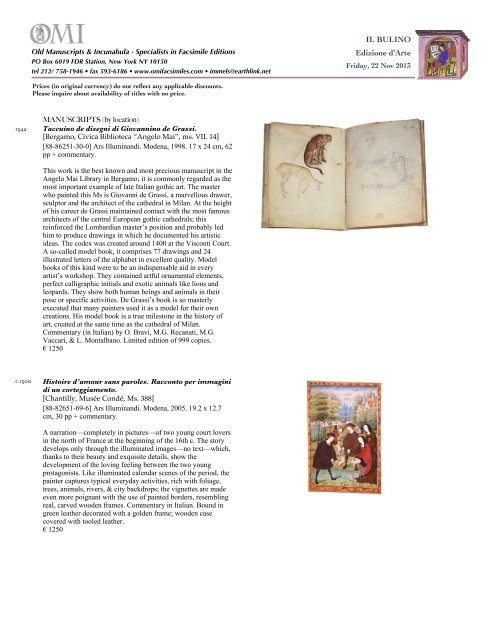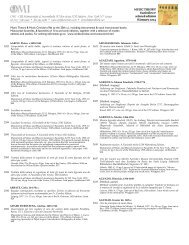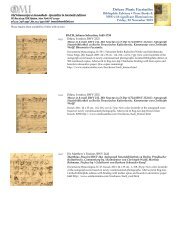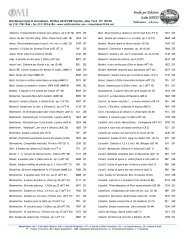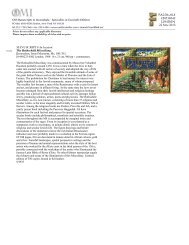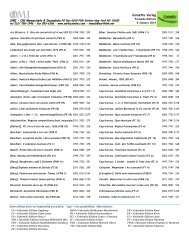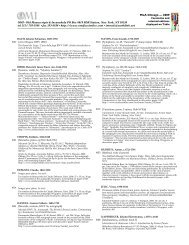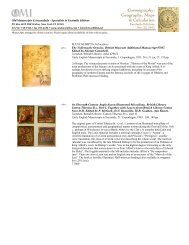Il Bulino facsimiles - OMI - Old Manuscripts & Incunabula
Il Bulino facsimiles - OMI - Old Manuscripts & Incunabula
Il Bulino facsimiles - OMI - Old Manuscripts & Incunabula
Create successful ePaper yourself
Turn your PDF publications into a flip-book with our unique Google optimized e-Paper software.
<strong>Old</strong> <strong>Manuscripts</strong> & <strong>Incunabula</strong> - Specialists in Facsimile Editions<br />
PO Box 6019 FDR Station, New York NY 10150<br />
tel 212/ 758-1946 • fax 593-6186 • www.omi<strong>facsimiles</strong>.com • immels@earthlink.net<br />
IL BULINO<br />
Edizione d’Arte<br />
Friday, 22 Nov 2013<br />
Prices (in original currency) do not reflect any applicable discounts.<br />
Please inquire about availability of titles with no price.<br />
MANUSCRIPTS (by location)<br />
1542 Taccuino de disegni di Giovannino de Grassi.<br />
[Bergamo, Civica Biblioteca “Angelo Mai”, ms. VII. 14]<br />
[88-86251-30-0] Ars <strong>Il</strong>luminandi. Modena, 1998. 17 x 24 cm, 62<br />
pp + commentary.<br />
This work is the best known and most precious manuscript in the<br />
Angelo Mai Library in Bergamo; it is commonly regarded as the<br />
most important example of late Italian gothic art. The master<br />
who painted this Ms is Giovanni de Grassi, a marvellous drawer,<br />
sculptor and the architect of the cathedral in Milan. At the height<br />
of his career de Grassi maintained contact with the most famous<br />
architects of the central European gothic cathedrals; this<br />
reinforced the Lombardian master’s position and probably led<br />
him to produce drawings in which he documented his artistic<br />
ideas. The codex was created around 1400 at the Visconti Court.<br />
A so-called model book, it comprises 77 drawings and 24<br />
illustrated letters of the alphabet in excellent quality. Model<br />
books of this kind were to be an indispensable aid in every<br />
artist’s workshop. They contained artful ornamental elements,<br />
perfect calligraphic initials and exotic animals like lions and<br />
leopards. They show both human beings and animals in their<br />
pose or specific activities. De Grassi’s book is so masterly<br />
executed that many painters used it as a model for their own<br />
creations. His model book is a true milestone in the history of<br />
art, created at the same time as the cathedral of Milan.<br />
Commentary (in Italian) by O. Bravi, M.G. Recanati, M.G.<br />
Vaccari, & L. Montalbano. Limited edition of 999 copies.<br />
€ 1250<br />
c.1500 Histoire d’amour sans paroles. Racconto per immagini<br />
di un corteggiamento.<br />
[Chantilly, Musée Condé, Ms. 388]<br />
[88-82651-69-6] Ars <strong>Il</strong>luminandi. Modena, 2005. 19.2 x 12.7<br />
cm, 30 pp + commentary.<br />
A narration—completely in pictures—of two young court lovers<br />
in the north of France at the beginning of the 16th c. The story<br />
develops only through the illuminated images—no text—which,<br />
thanks to their beauty and exquisite details, show the<br />
development of the loving feeling between the two young<br />
protagonists. Like illuminated calendar scenes of the period, the<br />
painter captures typical everyday activities, rich with foliage,<br />
trees, animals, rivers, & city backdrops; the vignettes are made<br />
even more poignant with the use of painted borders, resembling<br />
real, carved wooden frames. Commentary in Italian. Bound in<br />
green leather decorated with a golden frame; wooden case<br />
covered with tooled leather.<br />
€ 1250
<strong>OMI</strong> - <strong>Old</strong> <strong>Manuscripts</strong> & <strong>Incunabula</strong> • tel 212/ 758-1946 • fax 593-6186 • www.omi<strong>facsimiles</strong>.com • immels@earthlink.net IL BULINO, p.2<br />
1505-<br />
1510<br />
Libro d’ore di Alfonso d’Este. Offiziolo Alfonso.<br />
[Lisbon, Fundaçāo Calouste Gulbenkian, inv. L.A. 149;<br />
Zagreb, Strossmajerova Galerija, S.G. 339-352]<br />
[88-86251-50-5] Ars <strong>Il</strong>luminandi. Modena, 2003. 26 x 38 cm, 2<br />
vols, 358, 258 pp.<br />
This beautiful book of hours, also known as the “Offiziolo<br />
Alfonso”, was created by Matteo da Milano between 1505 and<br />
1510 on the commission of Duke Alfonso I. Considered the<br />
really last extraordinary work of Ferrarese illumination, it<br />
includes 29 full-page illuminations, numerous decorated borders,<br />
coat of arms and initials. The codex belonged to the Modena<br />
library until 1859 when it was taken by the Estense—along with<br />
the Bible of Borso and Breviary of Ercole d’Este—and<br />
conserved as the patrimony of the House of Austria-d’Este in<br />
exile in Vienna. 14 illuminations became subsequently detached<br />
(now kept in Zagreb) and the main body of the manuscript was<br />
bought by the Armenian collector Gulbenkian; this facsimile<br />
now reunites the two parts of this important manuscript.<br />
Commentary by Ernesto Milano and Manuela Fidalgo. Limited<br />
edition of 999 copies bound in full leather, with leather box.<br />
€ 3900<br />
1542 Inventario delle gioie di Isabella d’Este-Gonzaga.<br />
Codice Stivini. La collezione d’arte della Prima Donna<br />
del Rinascimento.<br />
[Mantova, Archivio de Stato, Archivio Gonzaga, D.XII.6].<br />
[88-86251-14-9] Ars <strong>Il</strong>luminandi. Modena, 1995. 17 x 24 cm, 48<br />
pp.<br />
Beautiful parchment MS from 1542, copied in sepia ink and<br />
adorned with sumptuous gold leaf borders, documenting the art<br />
collection of Isabella d’Este-Gonzaga (b.1474), the celebrated<br />
First Lady of the Italian Renaissance. Its compiler was Odoardo<br />
Stivini, the notary public to the Gonzaga court who catalogued<br />
the works conserved in Isabella’s “Studiolo” in the Corte<br />
Veccha, inside the Ducal Palace. The 236 inventoried<br />
items—including works by Mantegna, Giulio Romano,<br />
Michelangelo, Correggio and Perugino—attest to the high<br />
aesthetic taste and collecting “mania” of this leading figure in<br />
European culture. Commentary by R. Iotti, C. Cieri Via, L.<br />
Ventura, & C.M. Brown; transcription of the inventory by D.<br />
Ferrari. Limited edition of 600 copies, bound in leatherette, with<br />
box.<br />
€ 280
<strong>OMI</strong> - <strong>Old</strong> <strong>Manuscripts</strong> & <strong>Incunabula</strong> • tel 212/ 758-1946 • fax 593-6186 • www.omi<strong>facsimiles</strong>.com • immels@earthlink.net IL BULINO, p.3<br />
c.1500 Composizioni profane. Poesie musicali per le feste di<br />
corte.<br />
[Modena, Bibl. Estense Univ., it. 1221 (=alfa F.9.9)]<br />
Ars <strong>Il</strong>luminandi. Modena, [in prep]. Oblong, 17 x 12 cm, 180 pp<br />
+ commentary.<br />
Deluxe full-color facsimile of one of the most beautiful Italian<br />
songbooks of the Renaissance. A virtual anthology of strambotti,<br />
with 82 examples. The poetry, with Greek, Roman, Jewish,<br />
Christian, medieval and Petrarchan references, clearly points to<br />
the high humanistic milieu in which it was compiled. Deluxe<br />
leather binding with handsome tooling, following the design of<br />
the original extant binding.<br />
€ 790<br />
1534 Libro di devozione di Alberto di Brandeburgo.<br />
Est.136=alpha U.6.7.<br />
[Modena, Bibl. Estense Univ., lat. 136 (=alfa U.6.7)]<br />
[88-86251-24-6] Ars <strong>Il</strong>luminandi. Modena, 1997. 26 x 38 cm,<br />
256, 160 pp.<br />
This masterpiece of German book illumination, also known as<br />
the “Glockendon Prayerbook” after its illuminator Nikolaus<br />
Glockendon, was commissioned by the cardinal Albert of<br />
Brandenburg, prince elector of Mainz and a primate of the<br />
catholic church in Germany at the time of the Lutheran<br />
Reformation. It features 42 full-page illuminations, each divided<br />
into two parts: one, of smaller format, a scene from the life and<br />
Passion of Christ, is superimposed in the middle on a larger<br />
scene depicting the <strong>Old</strong> Testament. Each illuminated page<br />
carries the monogram “NG” of the artist. Glockendon, from a<br />
family of painters from Nuremberg, was clearly influenced by<br />
Albrecht Dürer and Simon Bening. The German text is in<br />
cursive Gothic script, enclosed in a red line box decorated with<br />
friezes executed by Georg Stierlein. The subject matter and types<br />
of devotion found in this book of hours link it to the school of<br />
German humanism associated with Erasmus from Rotterdam,<br />
advocate of a new intimate religiousness. Commentary (in<br />
Italian) by Ernesto Milano, Daniele Bini, Leandro Ventura, &<br />
Giancarlo Malacarne. Limited edition of 999 copies. Bound with<br />
full leather with generous tooling, with clamshell case in laid<br />
paper.
<strong>OMI</strong> - <strong>Old</strong> <strong>Manuscripts</strong> & <strong>Incunabula</strong> • tel 212/ 758-1946 • fax 593-6186 • www.omi<strong>facsimiles</strong>.com • immels@earthlink.net IL BULINO, p.4<br />
c.1460 Sphaerae coelestis et planetarum descriptio (De<br />
sphaera). [deluxe edition].<br />
[Modena, Bibl. Estense, mem. lat. 209 (=alfa X.2.14)]<br />
[88-86251-16-5] Ars <strong>Il</strong>luminandi. Modena, 1995. 17 x 24 cm,<br />
34, 117 pp.<br />
“De Sphaera”, written in Latin and Italian around 1460, is<br />
unquestionably the most beautiful astrological codex of the<br />
Italian Renaissance. It was illuminated for the Milanese Court<br />
(whose coat-of-arms is impressed on the binding) by an artist<br />
identified by numerous authorities as Cristoforo de Predis. It<br />
reached the Este dukes in Ferrara as part of the frequent cultural<br />
and political exchanges with the Sforza, rulers of Milan. This<br />
codex is glorious proof of a lay offshoot of the Renaissance and<br />
its counterpart, in the field of painting, can be seen in the scenes<br />
portrayed in the Schifanoia Palace frescoes. The first part of De<br />
Sphaera displays astronomical drawings and short captions,<br />
representing a synthesis of the coeval knowledge of terrestrial<br />
and heavenly phenomena. The second part consists of<br />
magnificent full-page illuminations which illustrate the influence<br />
of the stars on mankind: planets and zodiacal signs are<br />
represented, accompanied by pleasant scenes recalling courtly<br />
Renaissance taste. It is important to note that astrology was more<br />
than just a fancy at the European courts between the Middle<br />
Ages and Renaissance: it was a part of cultural life, a basic<br />
branch of knowledge and also a political matter. Commentary (in<br />
Italian) by Ernesto Milano, with contributions by L. Ventura &<br />
G. Malacarne. Limited edition of 999 copies, bound in full<br />
leather, with clamshell case.<br />
€ 1980<br />
c.1517 “Les petites prières” de Renée de France.<br />
Lat.614=alpha.U.2.28 Biblioteca Estense Universitaria.<br />
[Modena, Bibl. Estense Univ., lat. 614 (= alfa U.2.28)]<br />
[88-86251-28-9] Ars <strong>Il</strong>luminandi. Modena, 1998. 9 x 12 cm, 48,<br />
159 pp.<br />
This lovely Book of Hours, written and illuminated in the<br />
environs of Paris during the 1520s or 1530s for Renée de Valois,<br />
daughter of the king of France, Louis XII, came to Ferrara as<br />
part of her dowry when she married Ercole II d’Este in 1528,<br />
becoming the duchess of Ferrara. The prayers contained in this<br />
book of hours are strictly catholic, and this may explain why the<br />
codex survived the destruction of her books, ordered by the<br />
inquisitors in 1560, for Renée openly supported Reformed<br />
teachings and sheltered Huguenots and Calvinists. After her<br />
husband’s death, the duchess left Ferrara to retire to her French<br />
castle at Montargis. Renée's "Petites prieres" form one of the<br />
most refined examples of prayer collections for personal use: 12<br />
pages are entirely illuminated and decorated with colored and<br />
gilt friezes, within which the text, including 112 gilted<br />
illuminated initials, was written. This facsimile edition is now<br />
the only historical testament that we possess, as the codex was<br />
stolen in 1994 and is still missing. Commentary (in Italian) by<br />
Ernesto Milano. Limited edition of 999 copies, bound in velvet<br />
and hand embroidered with silver threads; leather-covered box.
<strong>OMI</strong> - <strong>Old</strong> <strong>Manuscripts</strong> & <strong>Incunabula</strong> • tel 212/ 758-1946 • fax 593-6186 • www.omi<strong>facsimiles</strong>.com • immels@earthlink.net IL BULINO, p.5<br />
c.1440 Liber Physiognomiae.<br />
[Modena, Bibl. Estense, lat. 697 (=alfa W.8.20)]<br />
[88-86251-39-4] Ars <strong>Il</strong>luminandi. Modena, 2000. 22 x 30 cm,<br />
76, 126 pp.<br />
The “Liber Physiognomiae”, consisting of a miscellany of<br />
medieval astrological treatises, was compiled in northern Italy<br />
around 1440. Written in round Gothic script and decorated with<br />
wonderful delicate watercolors, it starts with a general<br />
astrological discussion followed by a display of horoscopes for<br />
the twelve signs of the Zodiac. The codex turns out to be a real<br />
encyclopedia of astrological knowledge, with significant<br />
cross-disciplinary treatment, including charts for medical<br />
applications of astrological calculations, interpretations of the<br />
biblical dreams of prophet Daniel, and other medical astrology<br />
essays that can be ascribed to Pietro d'Abano, teaching at the<br />
University of Padua in the early 14th century. This connection,<br />
together with other historical and cultural clues, and the style of<br />
the illustrations recalling both Pisanello and Paduan<br />
astrological-type frescoes, suggest that this codex was created in<br />
the environs of Padua and Ferrara, perhaps on the behest of the<br />
Marquis Leonello d'Este. The facsimile, following the original,<br />
also reproduces the two "astrolabes"—rotating dials with<br />
moving pointers—allowing us to recreate the same calculations<br />
made at the time of the "Liber". Commentary by Daniele Bini,<br />
Paola Di Pietro Lombardi, & Leandro Ventura. Limited edition<br />
of 999 copies, bound in full leather, with clamshell case.<br />
€ 1100
<strong>OMI</strong> - <strong>Old</strong> <strong>Manuscripts</strong> & <strong>Incunabula</strong> • tel 212/ 758-1946 • fax 593-6186 • www.omi<strong>facsimiles</strong>.com • immels@earthlink.net IL BULINO, p.6<br />
1390 Libro d’ore del Maestro di Modena. Officium Beatae<br />
Mariae Virginis.<br />
[Modena, Bibl. Estense Univ., lat. 842 (=alfa R.7.3)]<br />
[88-86251-65-3] Ars <strong>Il</strong>luminandi. Modena, 2006. 15 x 21 cm,<br />
544 pp + commentary.<br />
The Lombard MS, dated 1390 and illuminated by the Master of<br />
Modena Hours (who takes his name from this exemplary codex),<br />
comes from the rich collection of the Marquis Obizzi del Catajo<br />
and has belonged to the Estense library since 1817. It features 28<br />
full-page illuminations, of which 15 have vegetation patterned<br />
borders and 21 have illustrated initial letters. The text, with<br />
indexed headings, is in rounded Gothic script. As is typical of<br />
prayerbooks, the first part begins with the calendar, followed by<br />
the texts of the prayers, accompanied by splendid illuminations<br />
representing important moments in the lives of the Blessed<br />
Virgin and Jesus and pictures of the saints. The codex is known<br />
as one of the masterpieces of Lombardian illuminated<br />
manuscripts and among those of the golden period of the<br />
International Gothic. The Master of the Hours Book of Modena<br />
has been traced to the workshop of Giovannino de Grassi, author<br />
of other wonderful codices for the Visconti court. Despite<br />
obvious references of this codex to the main school, the Master<br />
of the Hours Book of Modena reveals his own originality in his<br />
brush technique and background decorations, in his surprising<br />
elegance of line, and in the lovely gentleness of the feminine<br />
figures. Of considerable importance is the beautiful and<br />
sumptuous 16th c. pink silk binding with embroidered decorative<br />
borders along the spine and on the sides, in gold, silver and<br />
coloured silk thread. A framed bust of the Virgin Mary is<br />
embroidered on the front cover in the center, while the<br />
coat-of-arms of the presumed owner is embroidered in the center<br />
on the back. Limited edition of 499 copies, bound in silk with<br />
colored embroidery, after the original. Special transparent case.<br />
€ 7200<br />
http://www.omi<strong>facsimiles</strong>.com/brochures/modena_bh.html<br />
1390 Libro d’ore del Maestro di Modena. Officium Beatae<br />
Mariae Virginis.<br />
[Modena, Bibl. Estense Univ., lat. 842 (=alfa R.7.3)]<br />
[88-86251-65-3] Ars <strong>Il</strong>luminandi. Modena, 2006. 15 x 21 cm,<br />
544 pp + commentary.<br />
(same as above but with plexiglass slipcase)<br />
€ 4800<br />
http://www.omi<strong>facsimiles</strong>.com/brochures/modena_bh.html
<strong>OMI</strong> - <strong>Old</strong> <strong>Manuscripts</strong> & <strong>Incunabula</strong> • tel 212/ 758-1946 • fax 593-6186 • www.omi<strong>facsimiles</strong>.com • immels@earthlink.net IL BULINO, p.7<br />
1090-<br />
1100<br />
Parma <strong>Il</strong>defonso.<br />
[Parma, Biblioteca Palatina, 1650]<br />
Modena, 2010. 15.8 x 23 cm, 222 pp + commentary.<br />
The Parma <strong>Il</strong>defonso is an illuminated manuscript on parchment<br />
made in Cluny 1090 to 1100. A copy of “De Virginitate Sanctae<br />
Mariae” written by Saint <strong>Il</strong>defonsus (c.610-667), it is an<br />
impassioned theological work railing against heretics who doubt<br />
the purity of the Virgin Mary. The text may be a transcription of<br />
a Spanish copy destined for Bernardo de la Sauvetat, formerly a<br />
monk in Cluny and later Bishop of Toledo. (As Toledo had just<br />
been liberated from infidel occupation the text is connected to<br />
the reconquering of the Iberian peninsular.) The system of<br />
illustration is very complex: each one of the 222 pages is<br />
decorated with frames, painted in gold, silver or purple, with<br />
geometrical shapes or stylized leaves; inside the frames are the<br />
pictures or the text. Moreover there are 9 full-page illuminations,<br />
16 half pages, 8 smaller illuminations representing the prophets,<br />
9 big capital letters, 28 golden smaller letters and many other<br />
decorations. Deluxe limited edition of 499 copies. Full leather<br />
binding with slipcase covered with linen.<br />
€ 4750<br />
http://www.omi<strong>facsimiles</strong>.com/brochures/ildefonsus.html<br />
1474-<br />
1479<br />
Genealogia dei Principi d’Este. Vitt.Em.293 della<br />
Biblioteca Nazionale Centrale di Roma; alpha<br />
L.5.16=Ital.720 della Biblioteca Estense Universitaria<br />
di Modena.<br />
[Rome, Bibl. Nazionale Centrale, Vitt. Em.2 93; Modena,<br />
Biblioteca Estense Universitaria, It. 720 (=alfa L.5.16)]<br />
[88-86251-20-3] Ars <strong>Il</strong>luminandi. Modena, 1996. 26 x 38 cm,<br />
24, 206 pp.<br />
A sort of “portrait gallery” of Este princes copied by one<br />
illuminator of Bonifacio Bembo’s circle (c.1474-79). The MS,<br />
unique in its genealogical and iconographical approach, and as a<br />
history of dress, was intended as a noble "family album" to show<br />
important guests the family's wealth, power and illustrious<br />
origins. 169 members of the Este dynasty are portrayed,<br />
belonging to the first four centuries of Este rule - from 1095 to<br />
1479. The facsimile reunites two fragments, one in Modena, the<br />
other in Rome. Commentary (in Italian) by Ernesto Milano,<br />
Francesca Niutta, Margherita Maria Breccia Fratadocchi &<br />
Mauro Bini. Limited edition of 333 copies, bound with blue<br />
velet, with clamshell case in laid paper.<br />
€ 1400
<strong>OMI</strong> - <strong>Old</strong> <strong>Manuscripts</strong> & <strong>Incunabula</strong> • tel 212/ 758-1946 • fax 593-6186 • www.omi<strong>facsimiles</strong>.com • immels@earthlink.net IL BULINO, p.8<br />
700-<br />
525 BC<br />
Libro dei morti. Rotolo di papiro geroglifico.<br />
[Torino, Museo Egizio, n. 1791]<br />
Ars <strong>Il</strong>luminandi. Modena. 2007. Scroll, 18 m long , 29 cm high.<br />
Facsimile of a papyrus scroll of the saitic period (700-525 BC).<br />
It is a funerary ritual concerning the wandering of the soul in the<br />
other world. Champollion called it Funerary ritual, before<br />
Lepsius gave it the current title, Book of the Dead.<br />
Hieroglyphical red writing, in columns; black pictures are in the<br />
upper decoration; 6 main pictures are inserted within the text<br />
which is formed by 165 chapters. The text is the most complete<br />
one ever discovered. After it was measured for the facsimile<br />
edition, its size has been defined in 18,43 m in length and its<br />
height varies from 28 to 29,5 cm. The facsimile edition of 7<br />
copies was commissioned by the Italian Ministry of Culture: the<br />
first copy was donated to the new Library of Alexandria, Egypt,<br />
by the Italian government; six copies were reserved for national<br />
and foreign institutions that cooperated for the edition; other<br />
three copies belong to the archives of the publisher. The edition<br />
was digitally printed on a specific paper in 4 fragments that were<br />
then connected to each other and covered with binding cloth that<br />
allowed to roll up the papyrus and preserve it in a special case.<br />
13th c.<br />
Preghiera alla Vergine con le leggende di San Giiorgio e<br />
Santa Margherita.<br />
[Verona, Biblioteca Civica, ms. 1853]<br />
[88-86251-66-1] Ars <strong>Il</strong>luminandi. Modena, 2007. 17 x 24 cm, 84<br />
pp + commentary.<br />
Parchment MS, second half of the 13th century, possibly from<br />
the convent of St. Mary Magdalene. The first 2 folios, written in<br />
semi-cursive Gothic, contain the Prayer to the Virgin, one of the<br />
most ancient lauds in the Veronese tongue. The rest of the MS<br />
presents 2 texts written in rotunda Gothic: the legends of<br />
St.George of Cappadocia (ff. 3r-26r) and of St.Margaret of<br />
Antioch (ff. 27r-37v). At the end of the codex two full-page<br />
illuminations depict Christ with the four evangelists and St.<br />
Christopher. The artistic importance of the manuscript lies in its<br />
78 extraordinary miniatures that illustrate the legends of<br />
St.George and St.Margaret. The result is a wonderful narration in<br />
images, with a continuous relationship between text and<br />
illustrations. All the illuminations, perfectly preserved, have a<br />
strong connection in style with frescoes of the same period in<br />
Verona and show evidence of the influence of Bolognese<br />
painting. Commentary, edited by Daniele Bini, presents the<br />
complete transcription of the text and essays by Agostino Contò<br />
and Giuseppa Z. Zanichelli. Limited edition of 999 copies,<br />
bound with wooden boards covered with red leather, with straps<br />
and clasps.<br />
€ 2500
<strong>OMI</strong> - <strong>Old</strong> <strong>Manuscripts</strong> & <strong>Incunabula</strong> • tel 212/ 758-1946 • fax 593-6186 • www.omi<strong>facsimiles</strong>.com • immels@earthlink.net IL BULINO, p.9<br />
INCUNABULA, PRINTS, MAPS & DOCUMENTS<br />
1472 Carta del Cantino. Charta del navichare per le isole<br />
novament trovate in la parte de l’India.<br />
[maps, Cantino]<br />
Ars <strong>Il</strong>luminandi. Modena, 2004. 105 x 220 cm.<br />
Manufactured and illuminated in Portugal in 1502, this is one of<br />
the most beautiful geographical maps created in the Renaissance<br />
bearing witness to the discovery of America. The original<br />
consists of 6 sheets of vellum joined to make up a single 105 x<br />
220 cm sheet. Limited edition of 750 exemplars, numbered and<br />
certified, presented in a handsome archival box covered in blue<br />
linen.<br />
€ 1500<br />
1525 Planisfero Castiglioni. Carta del navegare<br />
universalissima et diligentissima.<br />
[maps, Castiglioni]<br />
[88-86251-46-7] Ars <strong>Il</strong>luminandi. Modena, 1998. 815 x 2140<br />
cm.<br />
The Castiglioni World Map is a large nautical map dated 1525,<br />
drawn on four sheets of vellum joined together to make up a<br />
single 81.5 x 214 cm sheet. Originally titled “Carta del navegare<br />
universalissima et diligentissima” (the most universal and<br />
accurate navigational map), the word “universalissima” refers to<br />
the whole hitherto-known world, and “diligentissima” the<br />
particular technical care employed by the cartographer. The map,<br />
crossed by lines defining nautical routes and forming rhombic<br />
patterns, is considered to be of great historical and cartographic<br />
interest in that it gives visual and documentary support to the<br />
theories of the curvature of the Earth. It has been attributed to<br />
Diego Ribeiro, head cartographer (‘piloto maior’) of the Casa de<br />
Contratacion in Seville (the government office of the Spanish<br />
royal family authorised to compile innovations in official<br />
nautical maps deriving from geographic discoveries). The<br />
Castiglioni World Map displays the world immediately after the<br />
discoveries made by Magellan and Pigafetta, during their<br />
circumnavigation of the globe, and from the explorations of the<br />
North American coast by Estevan Gomez. Presented in a display<br />
box.<br />
€ 1000<br />
1472 Collezione Portolani. Antiche carte nautiche della<br />
Biblioteca Estense Universitaria. [deluxe version].<br />
[maps, Modena, Bibl. Estense]<br />
Ars <strong>Il</strong>luminandi. Modena, 2004.<br />
A collection of 3 portulans perserved in the Biblioteca Estense in<br />
Modena (maps CGA5b, CGA5c, CGA5d). These ancient<br />
nautical maps, provided with a wealth of geographical coastal<br />
names, were conceived for being used by seafarers. Map “b”:<br />
Mediterraneo a dell’Europa nord-occidentale, 1460; Map “c”:<br />
Atlantiche, 1472; Map “d”: Mediterraneo a dell’Atlantico<br />
occidentale, 1450-60. With commentary and certificate of<br />
authenticity. Presented in a walnut showcase, sized 67 x 45 x 14<br />
cm.<br />
€ 2400
<strong>OMI</strong> - <strong>Old</strong> <strong>Manuscripts</strong> & <strong>Incunabula</strong> • tel 212/ 758-1946 • fax 593-6186 • www.omi<strong>facsimiles</strong>.com • immels@earthlink.net IL BULINO, p.10<br />
1472 Collezione Portolani, Antiche carte nautiche della<br />
Biblioteca Estense Universitaria. [standard version].<br />
[maps, Modena, Bibl. Estense]<br />
Ars <strong>Il</strong>luminandi. Modena, 2004.<br />
(Each portulan of this version is stored in a tube with<br />
commentary and certificate of authenticity).<br />
€ 1400<br />
1460 Portolano CGA5b. Carta nautica del Mediterraneo a<br />
dell’Europa nord-occidentale, 1460.<br />
[maps, Modena, Bibl. Estense]<br />
Ars <strong>Il</strong>luminandi. Modena, 2003. 90 x 61 cm.<br />
Stored in a tube with commentary and certificate of authenticity.<br />
€ 520<br />
1472 Portolano CGA5c. Carta nautica della atlantiche, 1472.<br />
[maps, Modena, Bibl. Estense]<br />
Ars <strong>Il</strong>luminandi. Modena, 2004. 60 x 73 cm.<br />
Stored in a tube with commentary and certificate of authenticity.<br />
€ 520
<strong>OMI</strong> - <strong>Old</strong> <strong>Manuscripts</strong> & <strong>Incunabula</strong> • tel 212/ 758-1946 • fax 593-6186 • www.omi<strong>facsimiles</strong>.com • immels@earthlink.net IL BULINO, p.11<br />
1450-<br />
1456<br />
Portolano CGA5d. Carta nautica del Mediterraneo a<br />
dell’Atlantico occidentale, 1450-60.<br />
[maps, Modena, Bibl. Estense]<br />
Ars <strong>Il</strong>luminandi. Modena, 2003. 90 x 61 cm.<br />
Stored in a tube with commentary and certificate of authenticity.<br />
€ 520<br />
1466 La cosmografia di Claudio Tolomeo (Atlante di Borso<br />
d’Este). [Modena, Estense Univ., alpha.X.1.3]<br />
[maps, Ptolemy, Modena]<br />
Ars <strong>Il</strong>luminandi. Modena, 2005. 31 x 45 cm, 256 pp +<br />
commentary.<br />
This illuminated MS is one of masterpieces of the Biblioteca<br />
Estense, purchased in 1466 for 100 gold florins by duke Borso<br />
d'Este (to whom it is dedicated) directly from the author, the<br />
German humanist Nicholas "Germanico". This new Latin<br />
version of Ptolemy's "Cosmographia" by Jacopo Angelo da<br />
Scarperia was accompanied by the 27 traditional maps<br />
re-elaborated by the author by using trapezoid projections. The<br />
text, written in two columns, is in humanistic characters, with<br />
the headings in gold capital letters underlined in red and<br />
illuminated initial letters. The text is divided into eight books;<br />
the first deals with theoretical subjects and representation of the<br />
globe while the others cover the regions of the earth. The double<br />
paged maps are framed by a gold border. The first plate shows<br />
the planisphere of the world while the other plates, preceded by<br />
an explanatory text, show the individual regions of the earth as<br />
they were then known. Commentary (in Italian) by Ernesto<br />
Milano, with transcriptions of the maps. Limited edition of 499<br />
copies, bound in full leather with decorations.<br />
€ 4500
<strong>OMI</strong> - <strong>Old</strong> <strong>Manuscripts</strong> & <strong>Incunabula</strong> • tel 212/ 758-1946 • fax 593-6186 • www.omi<strong>facsimiles</strong>.com • immels@earthlink.net IL BULINO, p.12<br />
c.1460 Apocalypsis Johannis. <strong>Il</strong> libro della fine del<br />
mondo.L’apocalisse.<br />
[Modena, Bibl. Estense, alfa D.5.22]<br />
[88-82651-29-7] Ars <strong>Il</strong>luminandi. Modena, 1999. 22 x 29 cm, 2<br />
vols, 50, 93 pp.<br />
A precious xylographic block-book, hand-colored, of Rhenish or<br />
Dutch origin. Known as the “Apocalisse Estense”, it is a<br />
beautiful example of the German art of woodcut engraving<br />
where various copies were printed with reproducible patterns,<br />
however, each exemplar became unique through its hand-colored<br />
addtions. Almost all the impressions (printed on the recto sides<br />
only) contain two scenes, parted by a frame. The images and<br />
simplified Latin texts make up a harmonious whole, the latter<br />
being distributed around or amidst the figures, a technique akin<br />
to modern comic book style. Commentary by Ernesto Milano.<br />
Limited edition of 999 copies, bound in full leather in the style<br />
of the current binding of the original; with clamshell case.<br />
€ 1250<br />
1511 La piccola passione xilografica - Norimberga 1511.<br />
[private collection]<br />
[978-88-86251-91-4] Studi e ricerchei, I Modena, 2011 15 x 21<br />
cm, 2 vols, 76, viii, 174 pp<br />
Dürer’s Small Passion series is considered his most unified set,<br />
carried out with a simpler more direct treatment of the subject.<br />
Dürer expanded here the usual cycle of the Passion by providing<br />
preceding and subsequent scenes, beginning with the Fall of<br />
Man and ending with the Last Judgement. The series was<br />
published in 1511 as a book with Latin text on the versos, the<br />
same year in which the artist’s three large books appeared.<br />
Commentary by Mauro Bini. Deluxe facsimile edition limited to<br />
to 199 copies, bound in full leather with gold stamping; with<br />
clamshell case.<br />
€ 960 http://www.omi<strong>facsimiles</strong>.com/brochures/duerer.html
<strong>OMI</strong> - <strong>Old</strong> <strong>Manuscripts</strong> & <strong>Incunabula</strong> • tel 212/ 758-1946 • fax 593-6186 • www.omi<strong>facsimiles</strong>.com • immels@earthlink.net IL BULINO, p.13<br />
1753 Le arti che vanno per via nella città di Venezia. 60<br />
incisioni di Gaetano Zompini - 1753. A cura di Daniele<br />
Bini.<br />
Zompini, Gaetano.<br />
[978-88-86251-92-1] Modena, 2011 43 x 30 cm, 2 vols, 60, 152<br />
pp.<br />
Collection of 60 etchings printed for the first time in 1753 by<br />
Antonio Maria Zanetti, Venetian publisher and intellectual. The<br />
work is a sort of illustrated encyclopedia of artists and craftmen<br />
who enlivened the streets of Venice in the 18th century. Gaetano<br />
Zompini "invented, designed, and recorded" the plates, while a<br />
friend, Don Questini, parish priest of Santa Maria Mater Domini,<br />
provided a descriptive rhymed triplet at the foot of each<br />
engraving. Gaetano Gherardo Zompini was born in 1700 in<br />
Nervesa, close to Treviso. In Venice, where he lived, he painted<br />
frescoes and oils for churches and palaces (like the dome of St.<br />
Nicholas of Tolentino), but also forecourts in Spain and<br />
Muscovy, some Bacchanalia for England and 8 mythological<br />
canvases painted for the Venetian Palace Zinelli which are now<br />
in Mosznej Castle, Czech Republic. Zompini embraced every<br />
kind of painting but was particularly prolific in the field of<br />
engraving. The "Venice of the Arts" of Gaetano Zompini is a<br />
capital city that lives the last gleam of its secular power, it's the<br />
Venice of Carlo Goldoni, great contemporary playwright. Just as<br />
Goldoni's comedies depict many facets of Venetian society,<br />
Zompini's illustrations graphically summarize daily habits and<br />
customs in the streets. The triplet in Venetian dialect<br />
accompanying each illustration completes the fresco, giving us<br />
detailed information about the material culture of mid-18th<br />
century Venice. Among the few known original specimens of<br />
Zompini's work is the one preserved in the Biblioteca Estense of<br />
Modena, the basis of this facsimile. Commentary by Danile Bini.<br />
Deluxe edition limited to 149 numbered copies printed on<br />
Fabriano paper Vergatona, handbound with a silk cover with a<br />
coat of arms impressed in gold; claim shell box.<br />
€ 1900 http://www.omi<strong>facsimiles</strong>.com/brochures/zompini.html


